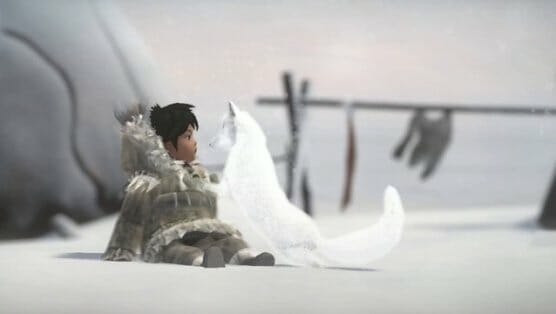Never Alone: Winter’s Tale

Modern geeks love to toss around the word “myth” for any story that involves more than two people that takes more than a minute to explain. You hear it most often and most embarrassingly in reference to comics, which definitely are rooted in myth, but you can take a cursory glance at DC’s New 52 and realize we’re not even in mythology’s zip code anymore.
Thing is, we have had the tools to truly propagate myth for some time now, and while sheer flights of fantasy enlighten, they aren’t the same. They aren’t the collective knowledge and experience of a people if what your story is and how you tell it is being decided by a small committee.
Never Alone is now a beautiful reminder of the difference. More than just another charming indie platformer, it IS, in fact, a collective effort by the Iñupiat people to bring their oral tradition into a new medium, where no such story has ever been told. The soul of a people, their morals, their values reinforced, retold, and strengthened by the telling itself, now given power and life by its very interactivity. It is, as the best myths are, a means of using fantasy to explore reality. And it is BEAUTIFUL.
Narrated by an actual Iñupiat elder, Never Alone is the story of Nuna, a young Iñupiat girl whose tiny village is on the brink of starvation thanks to a terrible blizzard. With nothing more than her warm clothes, and the unerring friendship of an arctic fox, she takes a journey to find the source of the blizzard.
It’s a deceptively simple story, and yet the stakes are high and tangible every step of the way. At the beginning, it takes all tiny Nuna has to even stay standing in the face of a cruel, unforgiving wind. When it’s not the wind, it’s nature itself: A polar bear, likely trying its best to survive the storm as well, chases her for what seems like ages. The ice under her feet can break at any given moment. The terrain itself is treacherous, uneven, seemingly working with the wind to daunt any who traverse. And when it’s not them, it’s a hideous abomination of an antagonist called the Manslayer, who has been leaving villages in ruins searching for treasures.
In Nuna’s corner, however, are the elders, the spirits of the frozen land, the animals, the northern lights, the things of legend that should be heeded if she is to survive the journey. Her fox companion can speak to the spirits, exaggerated caricatures of their nature that fade into existence to bring Nuna to where she must travel.
Stripped down to its barest elements, Never Alone is another in a line of platformers falling in lockstep with Limbo, of a small child running, jumping, climbing and solving puzzles in an overwhelming, immense world. But there’s a beauty here that Limbo, by its very nature, could never touch. If there’s a leitmotif to the whole game, it’s seeing the hidden grace in everything. There’s a tangibility and believability to this world even when at its most magical. We see the Iñupiat world through gentle, ethereal light, casting the pale, violet sun as otherworldly and familiar all at once. The trees are old, ancient, but creak and move and writhe in a way that commands fascination rather than fear. Even the polar bear that menaces Nuna throughout gives an impression of a creature that simply needs his next meal, afraid for his life. It’s a view of the harshest place on Earth from the eyes of those who live in respectful awe of it.
-

-

-

-

-

-

-

-

-

-

-

-

-

-

-

-

-

-

-

-

-

-

-

-

-

-

-

-

-

-

-

-

-

-

-

-

-

-

-

-









































